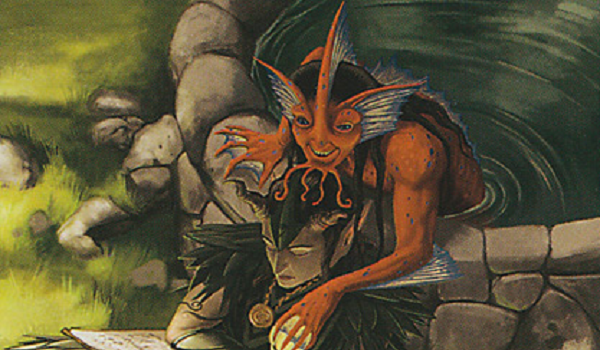Are you a Quiet Speculation member?
If not, now is a perfect time to join up! Our powerful tools, breaking-news analysis, and exclusive Discord channel will make sure you stay up to date and ahead of the curve.
Magic is no stranger to factory errors. Missing cards, wrong power toughness, wrong color, wrong mana cost, and wrong artist attribution have occurred since Alpha. However, misprinted cards have also existed just as long, and are some of the rarest and most sought-after cards for a small but growing group of dedicated players and collectors.
In 1994, I was one of the only people that was always fascinated by "error" cards. From misprints to miscuts to crimps, I have collected them all. For most of Magic's life, the group of players looking for these types of cards remained relatively small. Then again, so did the Magic population. With Magic growing larger every year, primarily fueled by Commander players, a new breed of collector has emerged. There is now a significant number of players building Commander decks composed entirely of error cards, which brings demand to a new level. Well, that is, unless Wizards has something to say about it.
Common Errors: A Primer
For an excellent beginner's guide, I can do no better than recommend MisprintedMTG. They have not only the most common of errors all laid out in an easy-to-digest guide, but also plenty of pictures of examples. I'm going to briefly go over just a few of the most common misprints and then point out where and how you can benefit from this knowledge.
Miscuts, Off-Centered, and Corner Cuts
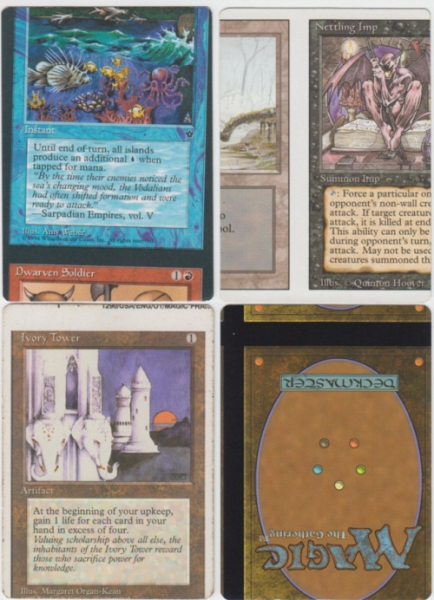
The defining characteristic of a miscut card is that you can see another card somewhere. Even just another card border can be enough for most people to agree it's a miscut. Of course, with this market, there are degrees to everything. Horizontal miscuts tend to be far rarer than vertical ones, and seeing a name of one card on the artwork of another tends to be a sweet spot that is ideal for most collectors. Since the name of the game is showing off the card, few people tend to care how the miscut looks on the back.
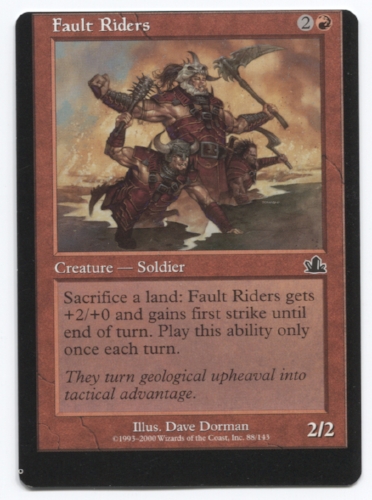
This is a very clear example of an off-centered card. Some collectors prefer all the cards to have the same alignment, and others don't have a preference of orientation but are looking at how extreme the error is. Like miscuts, few people seem to care if the back of a card is off-centered.
There are also NFCs, or non-factory cut cards. Wizards has given people uncut sheets of cards as prizes, and enterprising people decided to have the sheets deliberately miscut to increase their total value. Most error collectors are aware of NFCs and are not interested if more than two cards are showing.
Crimps
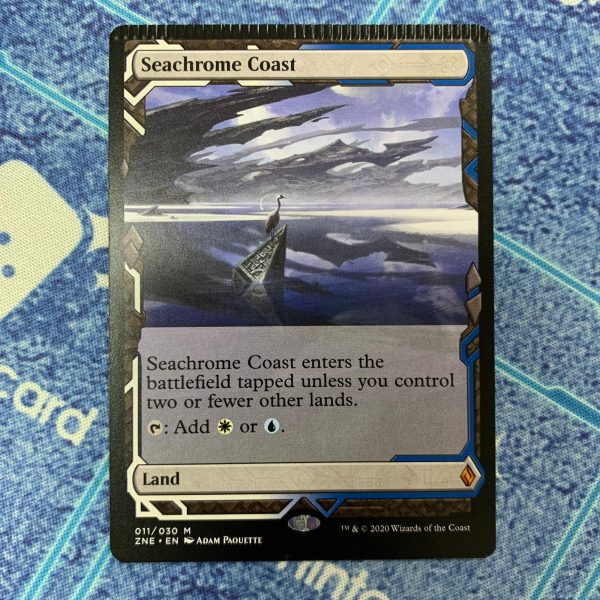
Crimps are another highly visible error. Sometimes your cards get into a fight with the crimping machine, and, well, the crimping machine wins. There are top crimps, bottom crimps, and even some across the center of card. Occasionally, a card gets crimped so hard it's cut in half, and each piece goes into a different pack. The physical look of a crimp is based on what set a card is from, and they can be extremely wide or just barely glancing an edge of a card.
However, note that it's entirely possible that a card was crimped outside of the factory. Because of this, it's a "buyer beware" error type. Still, crimps are very popular, even though they are technically damaged and could be inauthentic.
Corners
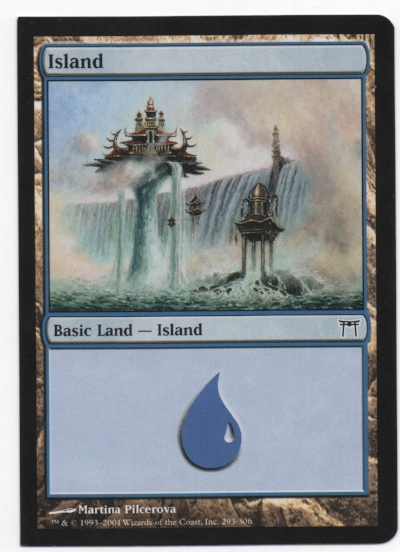
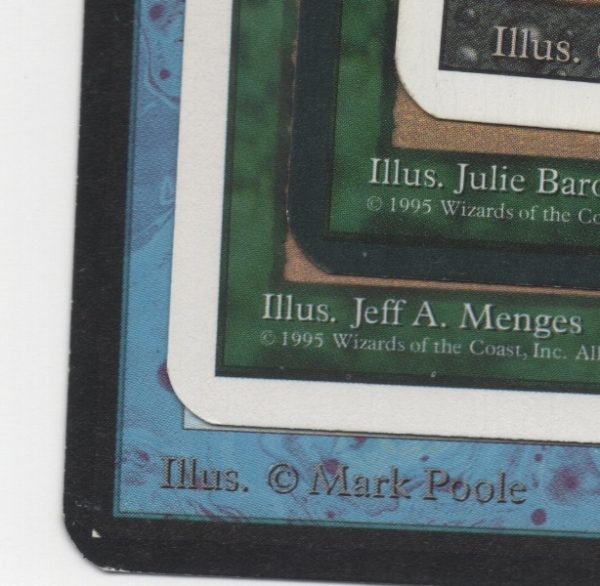
There are two main examples of corner cut errors. First, one or more perfectly square corners. Secondly, and this mostly applies to older cards, mainly 4th Edition, there are extremely rounded corners similar to the Alpha set. Square corners in particular seem to be a fairly prolific error in newer sets. Of course, much like a few of the error types above, "Alpha corners" technically could have been shaved down by unscrupulous actors, and may not be true factory errors.
Ink Dots and Color Errors
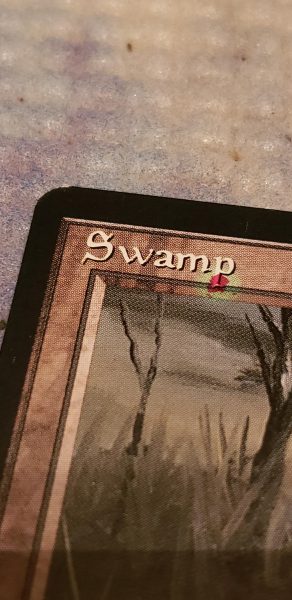
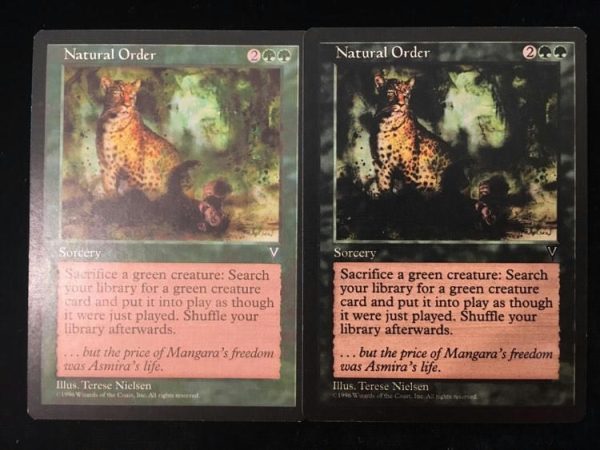
These are just a couple of examples of common printing errors where ink gets on a card, and too much or not enough color makes it to the final product. While it is easy to identify printer hickeys and ink splotches, or areas where a card is completely over- or under-saturated in ink, new cards are simply not as consistent as older cards in this way.
Because new cards are printed at multiple different facilities, they have higher, completely normal, color variance. The same goes for foils. There is a massive amount of variance in foils made today, and just because a foil is a little lighter or darker than normal it might not pass as a misprint.
Stamp Collectors, Rejoice!
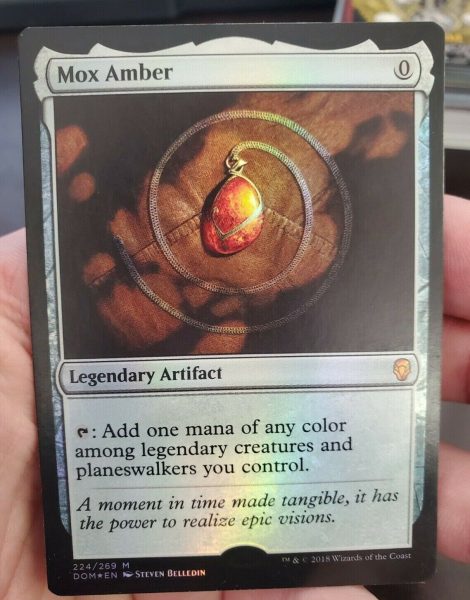
It did not take long for collectors to notice that once Wizards started adding holographic stamps to cards, there were notable errors. Stamps could be completely missing, significantly off-centered, partially missing, or indented into the card, and some cards received two stamps. Some collectors look for stamps that can be aligned perfectly, but are actually upside down.
Yes, looking at every single stamped bulk rare can yield a somewhat rare error that has a premium attached. Furthermore, pre-release and promotional cards which have date or logo stamps are an even rarer base card which can also have these types of errors, and are highly desirable.
Class Is Over; What Have We Learned?
Wow, there are a lot of different errors, and we only covered some of the most common ones. There are more color and foil variations than could ever be described. But what good is this information?
Well, there are collectors out there looking for even the smallest of variations in color, alignment, or foiling. While this has always been so, the total number of people looking for obscure rarities was relatively low... until Commander.
The Commander Effect
Commander has made the market for misprints crazy. Sure, there were a handful of players looking to build 60-card misprint decks and increase the size of their collection of oddities, but that was a minuscule pool. Now, there are a considerable number of players looking for a full 100 misprints for Commander, and oddity collectors on top of that. This creates a massive amount of demand that simply did not exist several years ago. When you look at price spikes for cards like Dan Dan based on a game variant and then consider the much more massive player base of Commander, it does not take a genius to see value appreciating. However, there are caveats.
Wizards is doing an incredibly bad job with quality control. It is empirically easy to see that virtually every single new card, no matter what edition, variant, or special treatment, has a few misprints available. In particular, the centering on modern cards is atrocious. Entire packs and boxes are off-centered or close enough to count. Furthermore, entire pre-constructed Commander decks are somewhat regularly miscut or off-centered directly from the factory.
Still, while the supply of misprints is growing alongside regular cards, the demand for these misprints is vastly outstripping it. Furthermore, as the population of rarity collectors increases, "what counts" for a misprint is becoming far more relaxed. Years ago, a modestly off-centered card would get a nod or a normal full-priced offer; no premium. Nowadays, many cards that are only slightly off-centered can easily net a bonus of twenty to fifty percent. For in-demand meta cards, two, five, or ten times normal retail value is relatively common, and more extreme misprints can yield exponentially more extreme values.
Are All Misprints Instant Money?
The short answer is "no," and the long answer is "it depends." Right now, there is an auction for a Nemesis foreign language double-printed card listed at $2,000.
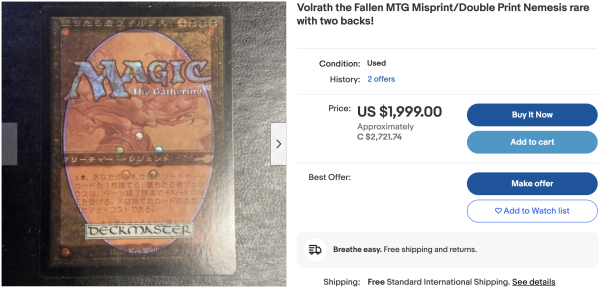
This is an ultra-unique card, and it's very likely a one-of-one in existence. However, a regular copy of the card is one dollar.
The card in question, Volrath the Fallen, is not a super popular card in Commander or Magic history at large. There might be one super Volrath fan that needs this exact card or perhaps a general oddities collector interested in it.
Greener Pastures
However, the opportunity cost of acquiring this one card is extreme. You can get several other, better, misprints for that amount of money, and those cards have a much greater chance of appreciating in the future.
Volrath? Not so much. Tying up money in expensive assets that have a low chance of appreciating is not a good idea, and it can be easy to do so if you're chasing the misprint market. It's far better to find deals that have an exceptional upside with virtually no downside.
The misprints market was once a bit insular and obscure. Now it's significantly larger and known. There are several Facebook groups dedicated solely to misprints, and they have card auctions daily. Large online retailers have misprint sections on their websites, and of course eBay auctions include oddities all the time.
Profiting From Misprints
If you have a large collection but have not scrutinized your cards very closely, now may be the time! Unlike something intentionally printed by Wizards to have artificial scarcity, misprints are the real deal and truly "one of one" in some cases. To the right buyer, it's a name-your-price kind of transaction. Here are four tips to profit from misprints.
1. Check Your Existing Inventory
You've already paid for what you own, so the cost here is simply in additional time. However, it's a massive time commitment to thoroughly check every single piece of cardboard. Your best bet is to focus on meta cards like the EDREC top 100, and anything commanding a high price is worth a closer look. If you have many thousands of cards from across the years, it's likely you may find a couple of hits.
2. Bulk Buys
When going through bulk, keep an eye out for misprints! These can be the best pulls that you may not even notice you're passing up. I've been to several stores with large inventory that charge full retail for bulk commons and uncommons, so if you did find a three-dollar common, they will charge you three dollars. However, paying full retail for misprint cards is one way you can win in this situation.
3. Binder Buys
Sometimes a binder contains a high-priced meta card that is a misprint, but it's priced normally. This scenario is surprisingly common and an easy way to plus on a transaction. The best part is that the high-demand meta cards are already picked out for you. This is an extremely easy way to turn $20 into $50.
4. Know Your Clientele
Finally, join a few dedicated misprint groups on Facebook or elsewhere and learn who collects what. Soon, you will readily sell crimps to Bill and right aligned off-centered cards to Sarah. This is the easiest way to turn cards you purchased for 50 cents into five dollars. Most collectors are always buying, and have a price range they tend to stick to. Learn what they are willing to pay and you can easily win on multiple cards.
Perfectly Imperfect
Hopefully you've learned a little bit about the misprint market and some of the strategies that can earn you a tidy profit. Do you collect error cards? What's the best misprint you have seen in the wild? Let me know in the comments. And happy digging!


